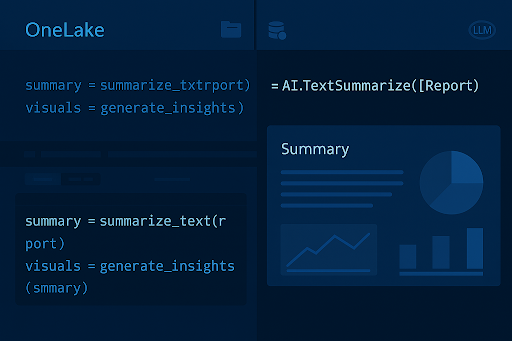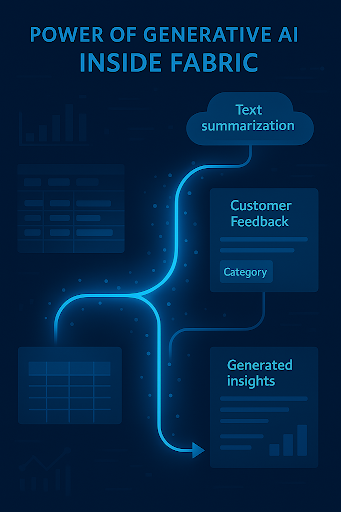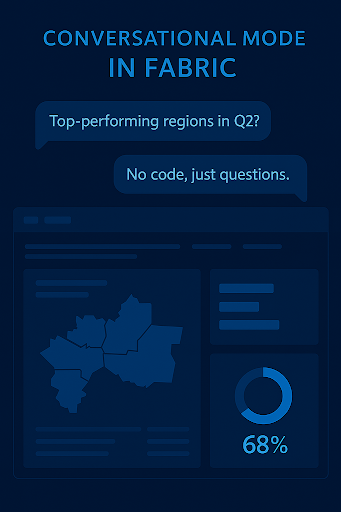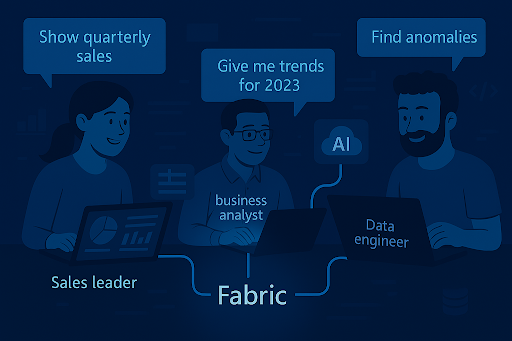
In the ever-evolving landscape of data analytics and business intelligence, Microsoft Fabric is carving out a new path by deeply integrating AI capabilities into the heart of data workflows. With the introduction of AI Functions, Fabric AI Skills, and conversational AI features, businesses can now transform raw data into insights faster and more intuitively than ever before. These developments are not just upgrades—they’re a glimpse into the future of real-time, AI-powered analytics.
Let’s explore what these innovations mean and how they can radically change how you work with data.
1. AI Functions (Public Preview): One Line of Code, Limitless Possibilities
At the core of the AI transformation in Fabric is the new AI Functions feature, currently in public preview. Designed for use within OneLake, these functions enable users to leverage the capabilities of Large Language Models (LLMs) directly in their data pipelines or semantic models—with just a single line of code.

Imagine writing a simple command to do what previously required complex scripting and external tooling:
- Text Summarization: Condense lengthy reports or documents into clear, concise summaries.
- Text Classification: Automatically tag and categorize incoming data streams—be it customer feedback, support tickets, or transaction logs.
- Text Generation: Use LLMs to auto-generate narratives, product descriptions, or business insights from structured data.
These capabilities bring the power of generative AI right into the world of enterprise data, opening up use cases from automated report writing to real-time customer sentiment analysis.

Conclusion: Data Meets Intelligence
With AI Functions, Fabric AI Skills, and the upcoming conversational features, Microsoft Fabric is not just becoming smarter—it’s becoming more human. These innovations will empower every user, regardless of technical background, to make faster, better decisions using real-time AI-assisted analytics.
Whether you’re a data engineer building scalable pipelines, a business user looking to self-serve insights, or a decision-maker seeking faster reporting cycles—Fabric’s AI roadmap is a game-changer.
As we head into 2025, expect a future where talking to your data is as natural as speaking to a colleague—and where the power of AI is just one query away.
The wait is over—Conversational Mode in Microsoft Fabric is now live as of early 2025. This groundbreaking feature allows users to interact with data through natural language queries, removing the need to manually write DAX or KQL.
You can now simply type:
“What were the top-performing regions by sales in Q2 last year?”
Fabric understands the intent, automatically generates the correct query, executes it, and returns the results—all in real time. This feature is transforming how teams access insights by democratizing analytics across departments.

Now, non-technical users like marketers, sales reps, and executives can get immediate answers without relying on data specialists, accelerating decision-making across the organization.

2. Fabric AI Skills: Conversational Mode is Now Live
Microsoft Fabric has successfully rolled out several powerful AI capabilities from its 2024–2025 roadmap. These now fully available features empower organizations to integrate LLM-driven intelligence directly into their data and BI ecosystems:
- LLM Text Enrichment: Use AI to enrich datasets by automatically generating summaries, classifications, and contextual keywords—streamlining everything from customer feedback analysis to compliance documentation.
- Azure AI Foundry Integration: With seamless connections to Azure AI Foundry, teams can now bring their custom-trained AI models into Fabric for domain-specific inference tasks—without needing to leave the Fabric environment.
- Natural-Language Semantic Models: Interacting with complex semantic datasets is easier than ever. Simply ask Fabric to “show quarterly profit margins” or “compare YoY revenue growth” and watch it interpret your intent with precision.
- Conversational AI Workflows: From dynamic dashboard building to automated responses to performance metrics, conversational AI now supports interactive, context-aware workflows within Fabric.
These milestones represent a significant leap forward—pushing Fabric closer to becoming a truly intelligent, self-service analytics platform.
